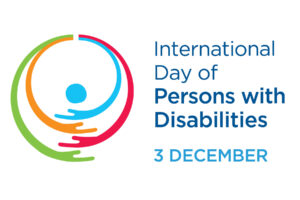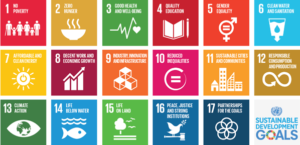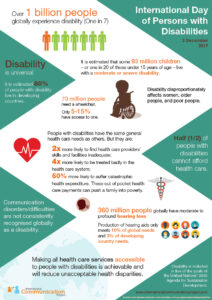Hello readers, thanks for joining us after a long absence of Access2Learn’s blog. We’ve brought the blog back today to discuss a very important, and in my own mind, chronically underrepresented day – the UN’s International Day of Persons with Disabilities. Celebrated every year on 3rd December, this day is dedicated to improving the lives of and removing barriers to over 1 billion people worldwide. That’s right readers, if you read our blog last year you might remember that the world population is approximately 7 billion in total; and 1/7 of said population has one form or another of disability. One in every seven. That’s a lot of people eh? According to the World Health Organisation, that makes disabled people the world’s largest minority.
Last year, you might remember that the theme was the attitudinal barrier to people with disabilities, very neatly summed up as “diversity, not disadvantage”. I really enjoyed writing that blog, and I strongly urge you to head to our website (https://www.access2learn.co.uk/social/) and check it out. However, this year’s theme is neatly summed as “The Future is Accessible” – another masterful slogan that deserves to be a hashtag – #thefutureisaccessible. The goal this year is to promote the participation and leadership of people with disabilities and acting upon the 2030 Development Agenda.
If you’re not familiar, the UN’s 2030 Development Agenda is an ambitious, multi-lateral effort by various UN countries that contains goals like eradication of poverty, gender inequality, improvement of education, cleaner energy and an entire list of noble goals, set to be achieved by – you guessed it, 2030!
But back to the real issue here – at least from the point of the purpose of this blog. If the future is indeed going to be accessible, what needs to change in order for it to happen by 2030 – or ever, for that matter? On a structural level? On an attitudinal level? In terms of outreach and resources? How far are we willing to go to make normal the changes that will allow those with disabilities to not only participate, but thrive?
There are a lot of things that need to be addressed to achieve this goal, but of course if I try to list and discuss them all in detail, it would take eternity! So I’m going to discuss some that I think are uniquely important, using my own perspective of life with a disability on things that closed doors for me personally.
At the risk of sounding like a broken record, I feel the need to reiterate something that I stated in my previous blog about this day, something that I feel cannot be overstated – the attitudinal barrier to disabled people. I spoke at length last year about how prevalent disability hate crime was and the employment gap recorded by the ONS between disabled and non-disabled people in the UK. In terms of hate crime, sadly it has only got worse – in fact the Home Office recorded in July 2019 that disability hate crime has increased by 1035 incidents from last year, bringing the total to 8,256 for 18/19. I do believe I also mentioned at one point that despite missing a 1st class degree by a whisker and having a capacity for writing that rivals the top 10% in Britain according to my diagnosis, the best work I could get for years after uni was washing dishes at a pub. Even today you can find articles on VICE or in the Guardian that talk about the experiences of disabled people who have made to feel like a drain on society. I personally feel that the treatment and exclusion of disabled people not only represents one of the biggest injustices in society, but also one of the biggest wastes. After all, was it not Einstein (Autistic, Dyslexic) who gave us E=MC2 and whose name is synonymous with “genius”, or Thomas Edison (Dyslexic) who at 6 had to take home a letter from the teacher saying “he is too stupid to learn” and then invented the lightbulb? What other strokes of genius would we be witnessing today, where it not for such a malignant vagary of perception that one must be non-disabled to be productive?
But dealing with the attitudinal barrier is only the first step. Taking the next step requires a focused and coordinated effort to provide something that I only wish I could have received as a child, and that thankfully I did receive at university, thank goodness – outreach. When somebody takes the time to reach out to you and help you, it makes a world of difference, both personally and professionally. Trust me, I know – I have been reached out to as a student, and I now provide the same courtesy to students for a living.
I arrived at university with barely enough UCAS points to make it, after making it into sixth form with only 5 C’s. Yep, 5 C’s – no thanks to anyone but me. As soon as someone took the time to reach out to me when I arrived at university, I found myself barely missing a 1st class degree by 2%. Pretty big difference eh? The confidence boost provided by the support available through Disabled Students Allowances, both in practical and psychological terms, makes an enormous difference for thousands of students each year, the same way it did for me back in the day.
But it is hardly coincidental. Negativity is a barrier in and of itself and can keep people from achieving their potential by making them doubt it’s there at all. For those who must cope with mental health conditions like myself, this negativity can be particularly ferocious. So imagine how refreshing and empowering it is to meet someone who knows what you are going through, who you can speak to on the level and is there to support you? Retrospectively speaking I would have killed for support like this at school. Of course, then as now schools are obliged by law to have a SENCO (Special Education Needs Co-ordinator – one person), though as I recall at my school I only met mine once or twice and didn’t even figure out who he was until decades later! Plus my school wouldn’t help me as I was not formally diagnosed, so it didn’t really help much either way in the end.
In July 2019 the Department of Education recorded an increase in pupils with SENs for the third year running, up to a new total of 1,318,300, approx. 14.9% of the total population of pupils. Only 3% ,however, (271,200) have an Education, Health and Care (EHC) Plan. Those with an EHC plan may get the adjustments they need to succeed in education, but what about the rest? Are school SENCOs equipped and/or informed of the individual’s needs? Do they have the resources or the manpower to cope with rising numbers of SEN students year on year? How about those healthcare professionals responsible for diagnosing and providing an EHC to students? Does the difference in students with and without an EHCP suggest difficulty getting support to everyone who needs it?
In my humble opinion, there are both material and immaterial barriers that prevent the participation of peoples with disability within society. If the UN wishes to change this, it will need to enforce both practical and intellectual opposition to the structural and psychological barriers that disabled peoples face. A fundamental shift must be enforced in the attitudes and perceptions that disabled peoples cannot or otherwise are not productive members of both staff and society. Perhaps a gentle reminder that they have a dyslexic man to thank the next time they switch on the lights?
Structurally speaking, there remain many barriers to participation of disabled persons, but I wholeheartedly believe that a huge step in the right direction would be to just reach out. It would provide a practical and psychological boost for people who want to participate in society, much the same way it did for me.
Thanks for tuning in for the return of A2L’s blog!
